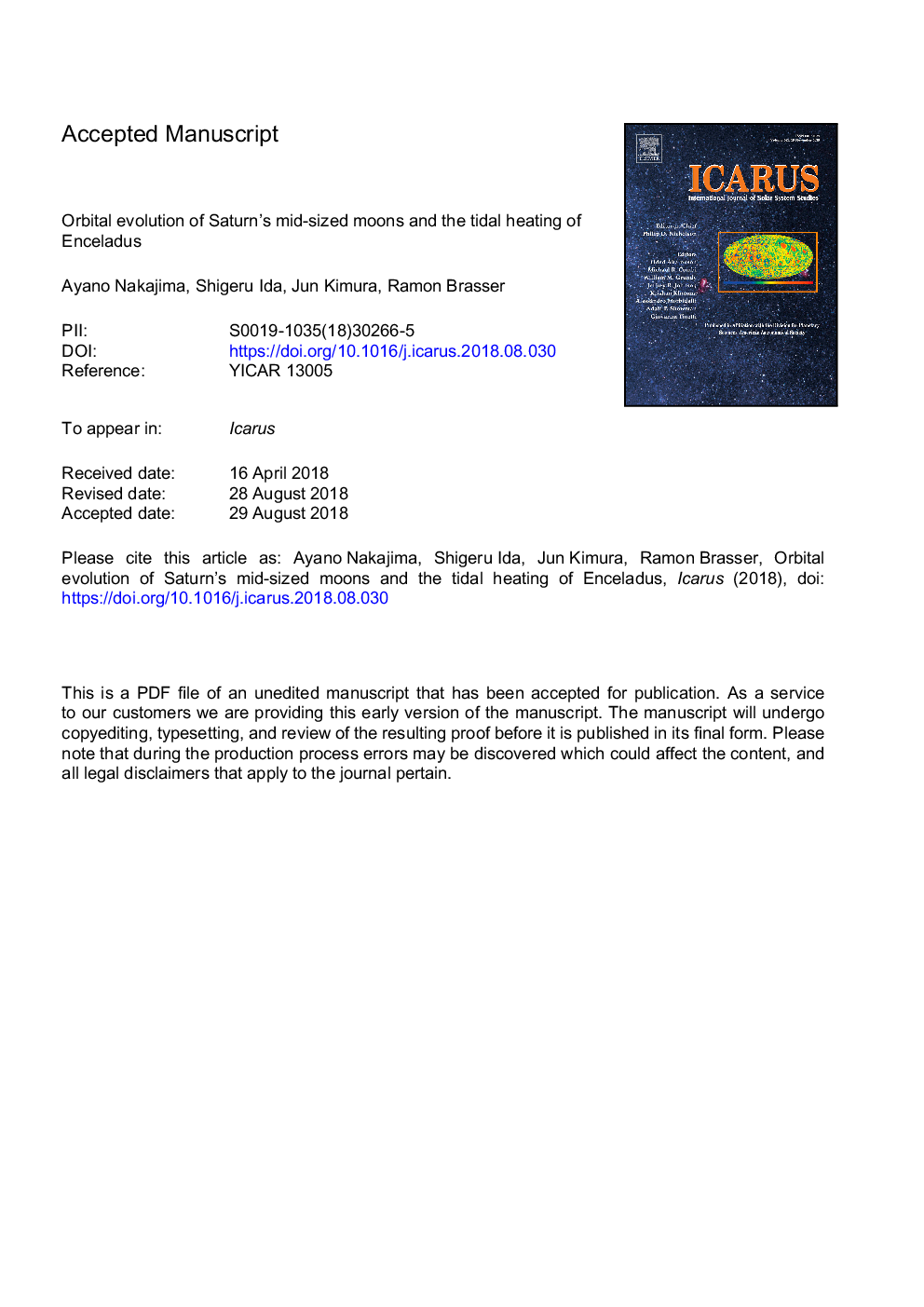| کد مقاله | کد نشریه | سال انتشار | مقاله انگلیسی | نسخه تمام متن |
|---|---|---|---|---|
| 9953764 | 1523475 | 2019 | 38 صفحه PDF | دانلود رایگان |
عنوان انگلیسی مقاله ISI
Orbital evolution of Saturn's mid-sized moons and the tidal heating of Enceladus
ترجمه فارسی عنوان
تکامل مداری از قمر متوسط قمر زحل و گرمایش جزر و مدی انسلادوس
دانلود مقاله + سفارش ترجمه
دانلود مقاله ISI انگلیسی
رایگان برای ایرانیان
کلمات کلیدی
زحل، ماهها رزونانس، انسلادوس، 00-01، 99-00،
موضوعات مرتبط
مهندسی و علوم پایه
علوم زمین و سیارات
علوم فضا و نجوم
چکیده انگلیسی
The formation and orbital evolution of Saturn's inner mid-sized moons - Rhea, Dione, Tethys, Enceladus, and Mimas - are still debated. The most puzzling aspects are 1) how the Tethys-Dione pair and the Mimas-Enceladus pair passed through their strong 3:2 mean-motion resonances during the tidal orbital evolution, and 2) the current strong heat flow from Enceladus, which is a few orders of magnitude higher than the tidal energy dissipation caused by the present orbital eccentricity of Enceladus. Here we perform N-body simulations of the moons' orbital evolution from various initial conditions - assuming that the moons were formed from Saturn's hypothetical massive ring - and investigate possible paths to solve the above difficulties. If the moons remain on nearly circular orbits and the influence of the rings is neglected, we find that the Tethys-Dione pair cannot avoid becoming trapped in the 2:1 and 3:2 mean-motion resonances as they recede from Saturn, and that the Tethys-Enceladus pair cannot avoid collisions after the resonance trapping, in case Saturn's quality factor is smaller than 15,000. These findings are inconsistent with the current orbital configuration. However, taking into account both the eccentricity excitation and the orbital expansion caused by the ring torque, we find that these resonance captures are avoided. With the relatively high eccentricity pumped up by the torque, Enceladus passes through all the mean-motion resonances with Tethys, and the Dione-Tethys pair passes through their 2:1 resonance and possibly the 3:2 resonance as well. After Enceladus resides beyond the 2:1 resonance with the outer ring edge, the eccentricity can be tidally damped. While this is a promising path of evolution, in most runs, Enceladus collides with Tethys by the excited eccentricity. There is a hint that a ring mass decrease (possibly due to Mimas formation) could avoid the collision between Enceladus and Tethys. The parameter survey taking into account detailed ring evolution and Mimas is left for future study. The heat that was tidally dissipated due to the eccentricity excitation by the ring torque in the past is stored in the moons and slowly radiated away through conductive transfer. The stored heat in Enceladus may account for the current anomalously high heat flow.
ناشر
Database: Elsevier - ScienceDirect (ساینس دایرکت)
Journal: Icarus - Volume 317, 1 January 2019, Pages 570-582
Journal: Icarus - Volume 317, 1 January 2019, Pages 570-582
نویسندگان
Ayano Nakajima, Shigeru Ida, Jun Kimura, Ramon Brasser,
